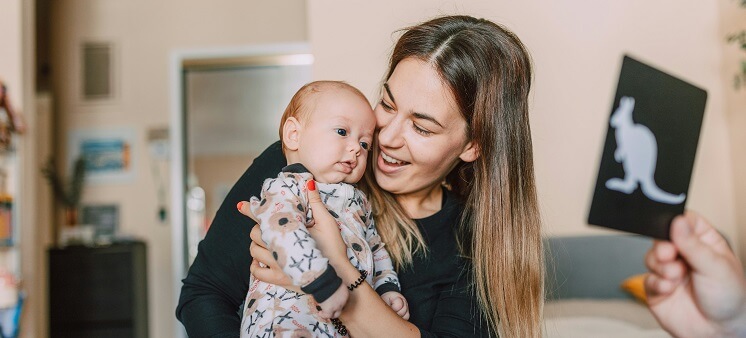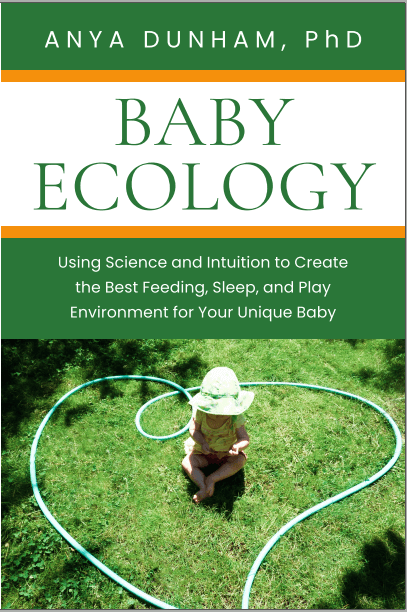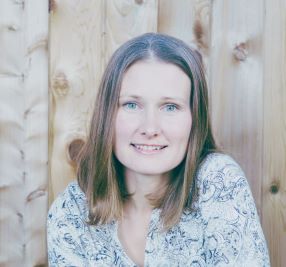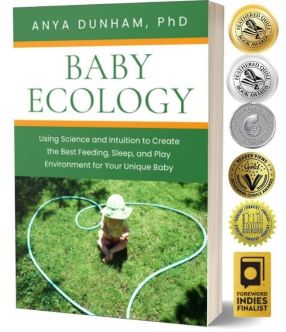Baby Ecology book is here! Learn more
Baby Ecology book is here!
- Home
- Baby activities
- Flash cards
Flash cards for baby: Are they necessary?
by Anya Dunham, PhD
Do 'flash cards for baby' help babies learn? Are they necessary? Let’s take a look at what the studies says.

Should you use flash cards with your baby? Are the claims that flash cards are necessary to help babies develop their ‘right brain’, eye tracking, and vision based on science?
Using flash cards as high-contrast images for visual stimulation in the early weeks
Many black-and-white (and sometimes red) high-contrast flashcards are available on the market for young babies. They are often called ‘baby sensory cards’.
It’s true that young babies see contrasting colors best. A newborn’s vision is not fully developed and that newborns have limited ability to detect color. However, both of these abilities develop and improve very rapidly: by 2-3 months typically developing babies are trichromatic (can detect all colors, although more intense colors are still easier for them) and can scan their surroundings quite thoroughly; by 6 months, they can see almost as well as adults.1,2
Babies are most interested in human faces, and can detect them very early on.3 They are especially drawn to faces when eye contact is present: they find the face faster and look at it longer.4 Watching and relating to a human face in real life is a more interactive and sensory-rich experience than looking at any image or pattern on a card. So the most stimulating object for your baby to gaze at and track with their eyes is not a set of flash cards — it’s YOU and other members of your family.

Using flash cards for baby to learn new words
What about using flash cards to learn new words?
Learning words requires matching sounds with objects or events they represent. It's especially beneficial when parents support babies' 'focus of attention' - notice and label what babies are already showing interest in. This is because it’s easier for babies to connect the words they are hearing with something they’re already naturally focusing on.5,6
Technically, this — noticing and supporting baby's focus of attention — can be done with flash cards as well. But unlike most other aspects of development, sensitive windows for sensory integration occur quite early in life,7 and it helps when babies engage multiple senses in a coordinated way.
For example, a baby might hear barking and see, and maybe even smell, the dog at the same time. Same with apple, rain, cloud, or anything else around them... And since flash cards for baby usually depict objects from real life anyway, you absolutely can wait till your baby discovers them in real life — and then talk about them in context.
Flash cards to teach babies how to read
A number of baby media products claim to teach babies to read starting as young as 3 months old. Even based on the studies mentioned above, you can probably guess that such products aren’t effective. One study compared 9 to 18-month-olds who were ‘taught’ using a baby media product (videos, word and picture flashcards, and word books) every day over a 7-month period, with similar age children who weren’t using the media product. Unsurprisingly, reading precursor skills (letter name, letter sound knowledge, print awareness, and decoding) and conventional reading (vocabulary and comprehension) did not differ between the two groups. In other words, babies did not learn to read using baby media, despite some parents displaying great confidence in the program’s effectiveness.8
Some of the best ways to prepare your baby for reading in later years is reading together and modelling the enjoyment of reading, as well as giving your baby ample opportunities for free movement and play.
Flash cards as toys
Finally, flash cards can be used as toys, as long as the materials are safe for baby to handle on their own. You can also ‘read’ them as books with your baby; this could be a nice activity (with benefits similar to reading books together).
Conclusions
If your baby enjoys flash cards, there is no harm in using them, especially as part of warm, sensitive interactions. However, flashcards aren’t necessary. All 5 key ‘ingredients’ babies need for learning can be provided without flash cards.
References
References
1. Slater A. (2002) Visual perception in the newborn infant: Issues and debates. Intellectica 34: 57-76
2. Maurer D, Lewis TL (1979) A physiological explanation of infants' early visual development. Canadian Journal of Psychology 33(4): 232-52
3. Bruce V, Doyle T, Dench N, Burton M (1991). Remembering facial configurations. Cognition, 38(2): 109–144
4. Simpson EA et al (2020) Face detection in 2- to 6-month-old infants is influenced by gaze direction and species. Developmental Science 23(2): e12902
5. Bergelson E, Aslin RN (2017) Nature and origins of the lexicon in 6-mo-olds. Proceedings of the National Academy of Sciences 114(49): 12916-12921
6. Landry SH, Smith KE, Swank PR (2006) Responsive parenting: establishing early foundations for social, communication, and independent problem-solving skills. Developmental Psychology 42(4): 627-642
7. Tierney AL, Nelson CA III (2009) Brain development and the role of experience in the early years. Zero Three 30(2): 9-13
8. Neuman SB, Kaefer T, Pinkham A, Strouse G (2014) Can babies learn to read? A randomized trial of baby media. Journal of Educational Psychology, 106(3): 815–830
Using hundreds of scientific studies, Baby Ecology connects the dots to help you create the best environment for sleep, feeding, care, and play for your baby.
Warmly,
Anya


